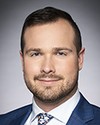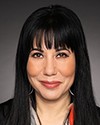Thank you. I'm not sure if Paul will join us, but if he does, you'll hear from him as well.
My name is David Stevenson. I'm calling in from the Lekwungen-speaking people’s territory here on Vancouver Island. It's an honour to be here.
Sekoh to everybody and thanks for inviting us to say a few words. I'm the CEO of the Moose Hide Campaign, which is a campaign that started along the Highway of Tears in 2011. Paul, who will join us in a minute, and his daughter Raven were hunting along that highway. It's their traditional territory. Their ancestors have hunted there for thousands of years, and when they got a moose, as they have done every year, they were inspired to take the hide of that moose and tan it, and cut it up and offer it to friends and relatives in their community who would agree, if they wore the hide, to promise not to do violence against any women and children in their community, and to honour, respect and protect all women in their lives and in their networks.
This was, of course, prior to the real awareness of the MMIWG issues that Canada has been plagued with. It was before the #MeToo movement and really before the TRC and reconciliation got going.
I'd like to point out that this was a moment that Canada needs to stop and think about. Here is an indigenous father transitioning his knowledge and wisdom, and his traditions and his language, to his daughter, and that was the exact moment that the residential school systems were designed to disrupt and to eradicate, that moment of transition of culture from one generation to the next.
That moment is also a moment when we see the power of culture and the power of the use of our collective ability to come together in cultures and design cultures and keep cultures alive and create new cultures, and that's what the campaign is about. It's very much about a focus on using an indigenous medicine, as we like to say, for the benefit of all Canadians and specifically for a very deep and troubling social and spiritual illness that Canadians suffer from. That's the illness of the confusion that violence is somehow a way to achieve some kind of goal.
Men are brought up in a culture in Canada, and many places in the world, where it is not obvious that you do not physically harm women and children. As a matter of fact, many men are brought up to think that this is one of the tools in their tool belt of how to move forward in life and how to achieve whatever it is they're looking to achieve.
The Moose Hide Campaign started at that moment as a call to action for all Canadians to stand together and draw a line in the sand. There was a time in Canada when drinking and driving was kind of okay. It wasn't great but it was okay. We didn't worry about it too much and there was a big grey zone there, and if you got pulled over you might get sent home or something like that. Then Canada decided no, that's offside.
That's not something we're going to achieve through the current tools of government. There are no laws or policies that somebody is going to write that all of a sudden will end violence against women and children in this country. What there is is the moral leadership.
So we ask for that in our engagement with government and all Canadians. Those are not necessarily the tools of government, but it's the leadership of government to say that this is an issue that is a priority to us. It's an issue that we want to focus on and take a stand against, visibly. We believe this is an issue, like all burdensome psychological issues, that can't be left in the dark. We hope that this campaign shines a light into that darkness and that we create the social connectivity and the social expectation that we conduct ourselves and that men hold themselves and each other accountable for a standard of interaction that they would like to see with their own daughters and their own mothers and their own sisters and themselves.
It's the result of a lot of confusion and a lot of yet-to-be-developed expectations, so we were glad to hear folks talking about youth. We have our Moose Hide Campaign Day, which is a virtual celebration. It will be on May 12 this year. We invite each and every one of you, and all of your networks, to join that event. We have about 250,000 people signed up. Close to 200,000 of them are in the K-to-12 system and we invite them to come and watch the day. We have the Governor General saying some words and Murray Sinclair saying some words.
What we're trying to do is set this issue above other issues. It's not just another issue among issues. It's not just a good idea that we work together to end violence against women and children. Violence against women and children is completely preventable. There's an experience and a set of values that we need to walk and talk.
We hold this day as a day of ceremony. We invite men and boys to fast with us for the day, so we get beyond this “It's a good idea” and “Yes, I feel this is the right thing to do” to “Oh, I actually have to deepen my personal experience and my personal commitment to take a stand.” We believe this is a muscle that has atrophied, if it ever existed, and it's a muscle we can collectively build together.
It's not everything. It's not going to solve all problems, but it's enough to say we collectively stand together on this issue. It's not simply a virtual signal, and it's not a badge of honour. It's a badge of our collective inability to provide a safe country for all Canadians.
That's the work of the campaign, and I'm happy to talk about any other aspects of it that you would be interested in.
Thank you.




